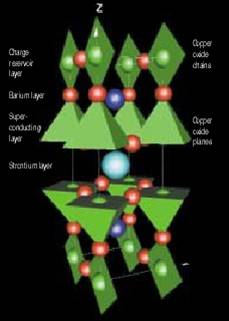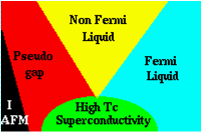High critical temperature (high-Tc) superconductors are copper oxides with a superconducting temperature as high as 130 K, approximately half the way between room temperature and the absolute zero. Before their discovery in 1986, the record in the `low' temperature supercondutors family of materials was a bit over 20K, thus the tremendous impact that the high-Tc discovery made in the condensed matter community is understandable. Applications were imagined, including the magnetically levitated trains in the figure. Although these applications have not materialized yet, the possibility remains open and it is widely believed that once the high-Tc materials are physically understood, a route toward even higher critical temperatures will become clear. The lattice structure of these compounds (see figure) is complicated, but they all have CuO2 layers, believed to be the location of the origin of the pairing. Superconductivity is obtained after the system is doped with hole carriers starting with an antiferromagnetic parent compound. A tremendous experimental and theoretical effort has led to much progress in this field of investigations, although still much remains to be done. In particular, the pairing mechanism is still not understood, as well as the linear resistivity with temperature at optimal doping, and features of the phase diagram such as the pseudogap regime (see phase diagram). At UT and ORNL numerous groups are working , at least part time, in this exciting area of investigations. The Spallation Neutron Source (SNS) under construction and the already available HFIR facility at ORNL will provide key neutron scattering data that will help understanding these materials.
 |
 |
 |